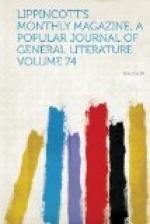It will readily be supposed that the scene at the opening of the sepulchre must have been a very impressive one. There, in that solemn chapel of white and black marble which the genius of Michael Angelo prepared for the repose of his sovereigns and patrons, with his lifelike and immortal presentations of the forms of the dead who have filled all story with their names, looking down on the deed with sad and solemn faces, who would not, while thus forcing the prison-house of the tomb to render up its terrible and long-concealed secrets, have been deeply sensible of a feeling of awe and reverence? Even putting aside all such sentiments as the contemplation of such a memento mori is usually found to inspire in most men, the purely scientific historical inquirer must have felt the importance of the occasion, and the great desirability of making the most in an historical point of view of so rare an opportunity. I am sorry to be obliged to record that the Florentines, so far as could be judged from their conduct and bearing, felt nothing of all this. No one who knows them as well as I do would have expected reverence from them under any possible or imaginable circumstances; but one might have expected such due care and decency of proceeding as would have sufficed to render the examination of the remains as historically instructive as possible, and to preserve the record for a future generation. But this was very far from being the case. A learned professor of anatomy indeed attended at the opening of the tomb, but instead of touching the remains himself, or utilizing his science by handling them as they ought to have been handled, he called a workman, and by him the bodies were torn out from their resting-place in fragments. The clothes were of course torn to pieces in the operation; the lace from the shirt of Alexander was permitted to be stolen; and the same fate, as has been stated, overtook his teeth. No sort of preparation had been made for any possible examination of the remains to any good purpose. They were laid out anyhow, as the phrase is, on a little marble bench in the chapel. Those who remember the place will not need to be told how perfect a sham any pretence of examination must have been under such circumstances. When this pretence had been gone through, the bones were cast back again into the marble sarcophagus by the workman, “like”—as one eye-witness of the scene describes it—“the bones of dogs.” And when the same person looked into the sarcophagus after this tossing back had been effected, he saw a mere confused heap of the scattered bones of two skeletons undistinguishably mixed together. “I cannot help,” writes the same eye-witness, “expressing my sense of the barbaric acts which I witnessed. Historic skeletons—the father of Catherine de’ Medici, the son-in-law of Charles V.; Florentine nobles—one a duke of Florence, the other of Urbino—both bad enough fellows, no doubt, but could any Communists have acted worse? Besides, Communist mobs assert




